There’s a problem in the world today, and I’m not talking about social media or crazy conspiracies. I’m not even talking about the ‘Rona – that’s for someone smarter to figure out.
The problem? Our dear 75-85+ year olds are stuck at home and watching TV, because they don’t have stereos. Imagine this. The hi-fi generation has been leapfrogged. Records? Oh, well y’know, the turntable became a chore to deal with. CD’s? We used to have a few..I think they’re in that bottom drawer over there. Streaming? Might as well be beaming up to another planet.
The music died. Apart from a squeaky little violin playing from the ancient transistor radio, and maybe a PBS broadcast from the Met, it’s gone.
Sorry for the drama. But you get my point. Think about your in-laws, your Aunt Edna, your Grandpa Joe. Do any of them have working stereos? Not likely. It’s hard enough to keep their email going, and record their favourite television shows. And it’s not their fault. If I was 80 and walked into Best Buy to look at audio gear, I’m sure I wouldn’t have a clue where to start, or what half these gizmos are even for. The 18-year-old sales kid isn’t likely to be much help – it’s too big a gap. Yes, there’s inherent ageism baked into the whole electronics/hi-tech revolution. That’s why a 12-year-old has to teach you to use an “intuitive” app like Instagram – it was designed for them, not for you.
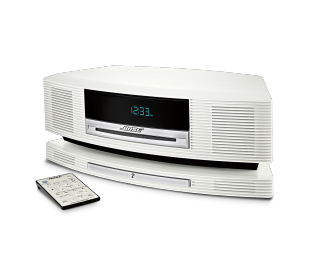 So it’s up to us to figure something out here, gang. I think for years the fallback has been the Bose table radio, Tivoli, etc. We found a Bose “Wave” CD/Radio for my mother in law a few years ago – it was what she had wanted. Well, being unbothered by its appearance, she gave it a prominent place in the living room. And then hardly ever used it. Seems that part of the house isn’t conducive to receiving the only radio station she likes. (or maybe the sound wasn’t that great?)
So it’s up to us to figure something out here, gang. I think for years the fallback has been the Bose table radio, Tivoli, etc. We found a Bose “Wave” CD/Radio for my mother in law a few years ago – it was what she had wanted. Well, being unbothered by its appearance, she gave it a prominent place in the living room. And then hardly ever used it. Seems that part of the house isn’t conducive to receiving the only radio station she likes. (or maybe the sound wasn’t that great?)
Prior to that (15+ yrs ago), my father in law had installed an Onkyo 7.1 HTIB setup – he even ran the wires to the side and rear speakers inside the walls. This was all good, the trouble was integrating everything. Too many remotes, too many things to remember. And it didn’t give them much in the way of music. As time passed, the Onkyo system became an unused relic and a dust magnet.
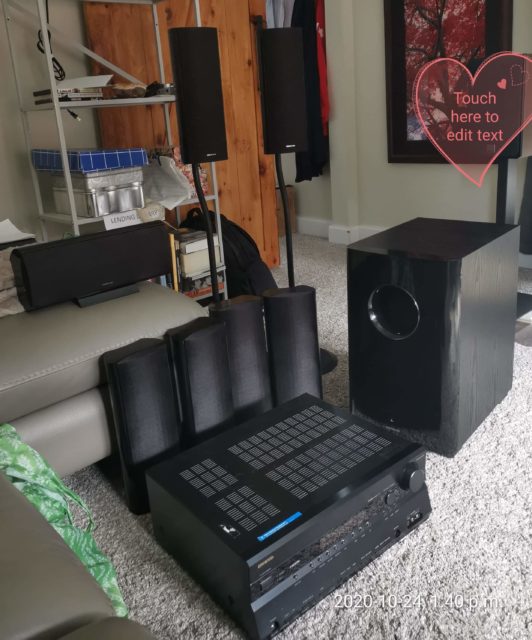
Fast forward to 2020.
There are so many different ways to approach this conundrum. For me, the key questions are 1) how much music do you want to listen to? And 2) can you use a smartphone (or tablet)? If the use is casual and smart devices are a grief-causer, then I might suggest something like a Sirius radio, or Stingray (music channels on TV, in Canada). But if the answers are “quite a bit”, and “yes”, then the door is open to music streaming services – and potentially a much more enjoyable experience, for not a lot of money.
My mother in law, let’s call her Ingrid, is quite comfortable with a smartphone. My father in law, let’s call him Jim, has never used one and likely never will. Meanwhile, my wife (we can call her Bonnie) has become an avid Spotify user, and maybe a wee bit of an audiophile. Bonnie is in love with the Bluesound Powernode 2i streaming amp, as well as the DALI Oberon 5’s that David recently reviewed and bought. And so, this happened at my in-laws last month:
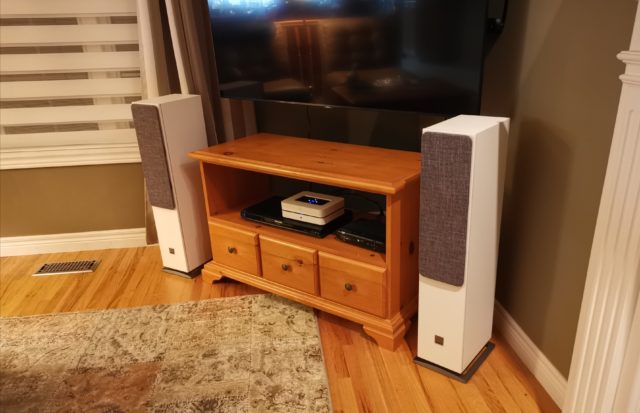
This unassuming little setup sounds incredible, and is so simple any 5-year-old could teach you how to use it in 15 minutes. There isn’t even an on/off switch. The Powernode goes to sleep when nothing’s happening. It wakes up when you start the app, or turn the TV on. No fuss, no muss. Hook it up to a decent pair of speakers and prepare to be amazed. This isn’t a review per se. David covered the DALI Oberon 5’s. The Powernode has loads of great reviews – possibly none better than John Darko’s youtube review, “Escape the world of Crazy”.
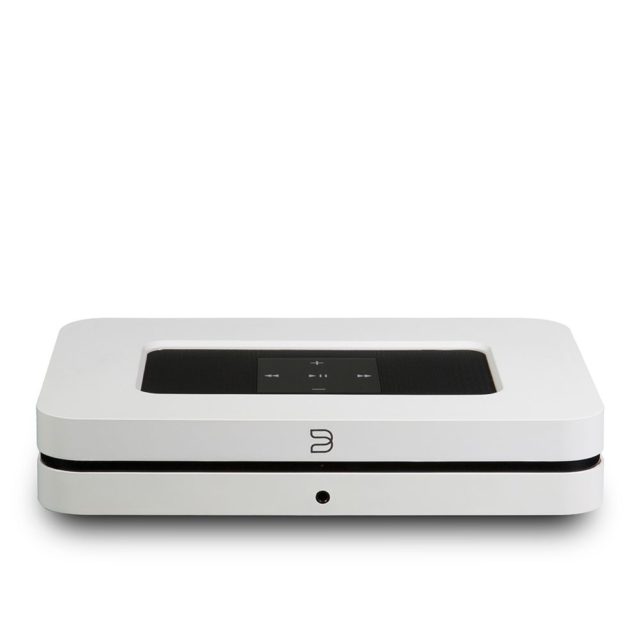
I’m well aware that many audiophiles still regard a “one-box” unit like the Bluesound with suspicion. Which is a shame, because guys, this is so much better and so much easier, for so many more people – it’s illogical to ignore the benefits. It’s not just 30 million songs in your pocket, it’s hi-fi that integrates with your life. What’s the better option, a hi-fi that regular people can enjoy but is maybe a bit “lowbrow” to you – or NO music? I rest my case.
The proof I offer is this. My very non-audio in-laws have been raving to us (and anyone who’ll listen) about how great their stereo sounds. They’re over the moon. And they’re right, it sounds excellent. And the kicker: the Noam & Bonnie Tech Support Line has been dead quiet. No issues, no calls for help.
In fact the only “stress” has been a re-awakened disparity in music preferences. Ingrid likes Chopin. Jim likes The Beach Boys, and Mamma Mia. They both agree on Enya.
Now of course, you do have to be prepared to spend some time with set-up. Namely creating a playlist or two, and going over the basic functions of the app. Still, Bonnie handled 95% of that with her mom, and after about 6 weeks, the sum total of effort has only been around 2 hours.
Two hours of help, for years of musical delight. That seems like a no-brainer to me. By the way – Bluesound, one of the great audio success stories of the last decade, is a wholly Canadian-owned company: as the Lenbrook folks say, it’s the child of NAD and PSB.
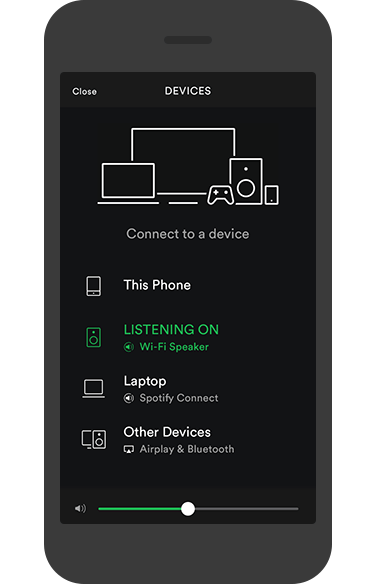
Of course, it could be even simpler. Get a pair of ‘wireless’ (powered) bookshelf speakers, set up another member on your Spotify family account, and log them in. But those will typically be Bluetooth-based. As is the infamous “Bluetooth Speaker”. There’s nothing wrong with that, and depending on the person, it could even be a godsend – for example, a voice activated speaker playing music for someone who’s bedridden, or has severe vision impairment.
But with audio solutions like Bluesound, Sonos, or DALI SoundHub, they utilize your home WiFi – and the result is much less compromise in sound quality. Similar convenience, just a little more investment. Nowadays.. what else can people spend their money on anyway?
Bluesound in particular has really impressed me – the company is part of Lenbrook Canada, which also owns NAD and PSB (and distributes DALI, Master & Dynamic, and Tivoli). Two solutions in particular ring all the right bells for me:
- Bluesound Node 2i streamer/DAC + powered speakers (or headphones), or
- Bluesound Powernode 2i HDMI amp/streamer/DAC + passive speakers
Both are dead simple, elegant, small footprint answers to the problem we’re addressing today. Take your pick. We went the latter route – in large part because the Powernode has an HDMI ARC input. This means when the TV is turned on, the Powernode wakes up, automatically switches to the HDMI input, and – best of all – the TV remote is all that’s needed to control sound, in glorious hi-fi stereo. You can connect a subwoofer too, if you like.
(and as modern and connected as the Bluesound setup is, it still earns the legacy “My Stereo Doesn’t Spy On Me” certification)
Want to go higher end? How about a NAD Master Series M10 – a 100wpc hybrid digital amp with “integrated everything”, including a gorgeous colour touch screen and Dirac room correction. At a cool $3499 CAD, it will please your more well-heeled relatives, though they may not hear a big difference from the $1100 Powernode.
There are, of course, tons of different audio products in the modern age. You might look at something like B&W’s Formation Wedge (I think this replaces their “Zeppelin” line), or iFi Audio’s Aurora, pictured above. The sky’s the limit. I have to admit – even my son’s $25 Bluetooth 5 speaker from Radio Shack has pretty decent sound quality for what it is.
We could turn this into a series, if other WoS writers want to contribute their thoughts. Readers can use the Comments section below and let us know what you’ve discovered out there. Wall Of Sound aims to bring you a diversity of topics and opinions – we have plenty of those. Your thoughts on our articles are always welcome.
I’ll leave it there for today, with one last thought. Rock on, Ingrid and Jim.
Author’s Proviso: Although this is a general article, I am also a dealer of Lenbrook products, in my main hustle Stereo Untypical.

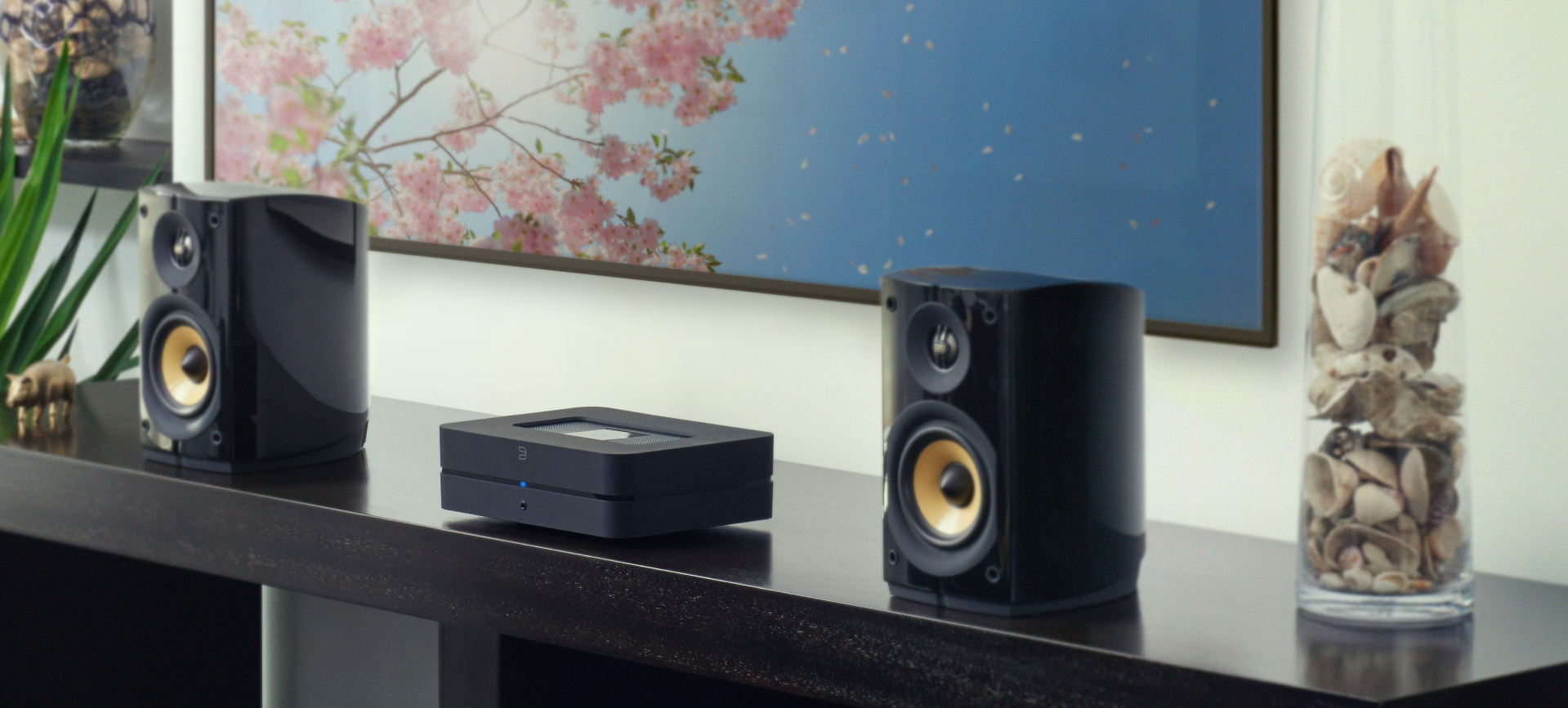
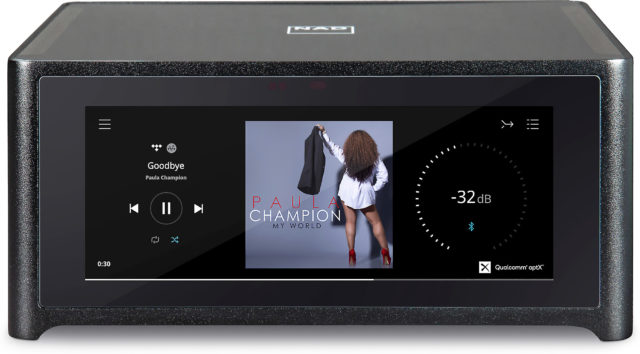
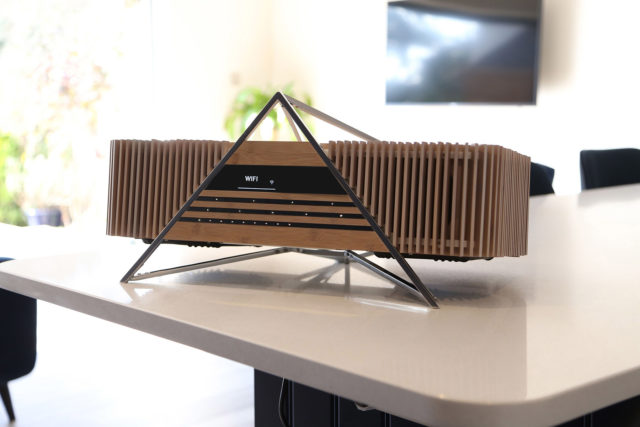
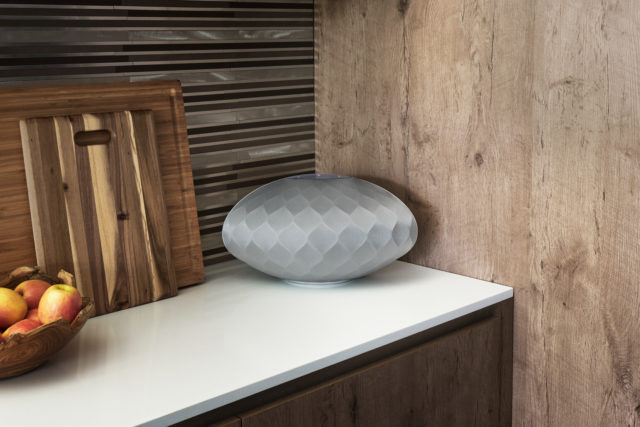
Kef LSX is another option…..only disadvantage is I don’t think it wakes itself up automatically. It has all the streaming options and airplay2.
Thanks for commenting, Mike. Yes, there are so many good powered speaker options now, even well below $1000.
Noam
I installed a white Powernode yesterday at my GFs home, a 66 years old lady who cannot be bothered with complex electronics; pity it is so difficult to make a share on a Windows PC ( Took me, an IT guy, almost 30 minutes) but the machine is fantastic; beautiful smart versatile compact machine with a sound quality that is uncomfortably close to my NAD C390DD with BluOS module, a far uglier machine bought for more then 3 time the price of the Powernode.
Pay attention, Sonny — I’m pushing 70 and I’m the friend and family member my kids, grandkids and others call for this sort of help. But their music sucks and they need to stay the hell off my lawn.
Haha, thanks for that Gerald.
I think most of us are pushing 70, or some similarly daunting number…
Noam
Hi Noam!
It’s great that you’ve taken on this topic, it is incredibly necessary and important.
It is very helpful that you have identified the Bluesound Powernode 2i as a leading contender for the SilverFox Audiophile Gear Award (SAGA!).
Since we last spoke, I bought a used Naim UnitiQute 2 on CAM for my parents, and just got home from setting it up. Dad, who is going on 89, is chuffed, and declared that “I think the box and I will be friends.”
This leads me to thoughts on key success factors, beyond selecting the simplest and most intuitive product around:
– even the best thought-out quick start guides and installation instruction (looking at you, Apple) can be daunting enough to turn the aging mind off; and those minds come by it honestly, first because of decreasing neuroplasticity and learning ability, and secondly because even the easiest quick start guide will ultimately be dealing with network connectivity. It awaits us all. I suspect that even Ingrid might have trouble with this without Bonnie’s support. In my experience, this is the river too deep and mountain too high, especially if it goes anywhere beyond entering a wifi SSID and PW.
– Hence, I think installation and configuration are areas where audio manufacturers, marketers, distributors, and retailers have a challenge and opportunity for Ingrids who may not have Bonnies to help. Where in-person setup assistance is not feasible, what about telephone-delivered setup and installation support, with empathic, patient, step-by-step guidance? If every computing support service already starts with “have you plugged the computer in?”, would this be so much of a stretch for a nominal fee? (Of course, certain conscientious audio dealers will already do this as a matter of course)
– If we hive off installation per the above from operations, I think the next thing to address are user manuals, whether quick start of reference. To my mind, the problem is that many seniors need answers to 3-5 questions, that’s it, that’s all. Quite literally: what button do I push to turn it on and off? How do I adjust the volume? How do I select my source? Of course, every manual deals with such basic issues, but the process of combing through an opaque manual to find answers to the few critical questions can be daunting to the point of failure. With the UQ2, I sat down at the computer, grabbed a couple screenshots of the remote, and explained briefly which buttons to push for what operations. And guess what, success: notoriously anti-tech Mum read it and said: got it loud and clear! The conclusion I draw is that while manufacturers can’t stop producing the standard documentation, it can be a barrier for this particular target audience, and there is an artifact/resource missing for them. One might imagine a crowdsourced website of streamlined materials for the non-geek.
Cheers, Mark
–
Hi Mark,
Thanks for your thoughtful comments, those are excellent points. You’re right that a lot of tech today pre assumes you are already comfortable with network connectivity, WiFi, etc. In the case of Bluesound – their parent company Lenbrook is quite obsessed with dealer training. They offer us a training webinar once a week just about all year round. And I think dealers are (or should be) the go to resource for user support. With elderly folks I’ve found that with anything smartphone or tablet related, the key is practice – if you can get them to try the app (themselves) 5-10 times, they’ll have the confidence to use it. Otherwise it can fall into the intimidation category.
Definitely helps if us “juniors” are willing to help our parents keep up…
Noam
I found Bluesound’s tech support, including phone support, to be very helpful indeed. I believe the same desk is now handling all of the tech support for NAD as the two are so connected now, what with the ubiquity if the NAD Bluesound expansion modules.
Thanks for your comment, Gord. The NAD, PSB and Bluesound brands are all part of Lenbrook Industries.
Noam